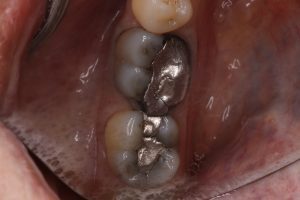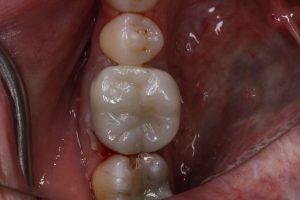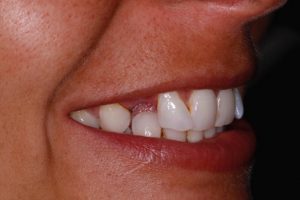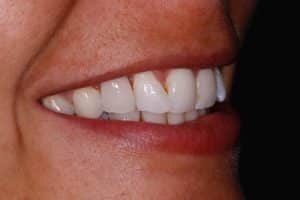Telephone: 01509 219 699
Email: info@carillondentalcare.com
A dental crown is a cap that is placed over a tooth and held in place by dental adhesive or cement. Dental crowns are used for several reasons:


“This is a before and after image of a heavily filled tooth that has been replaced with a dental crown, which has been colour-matched to the patient’s natural teeth.”
Dental bridges replace one or more missing teeth by joining an artificial tooth to adjacent teeth or dental implants.
Our dentist, Dr Hemal Charadva, has written a blog post where he talks the options for replacing missing teeth – click here to read the blog. You may find this useful if you are considering a bridge, denture or an implant.


*Here is a before & after image of what a bridge would look like if you have a missing tooth
Crowns can be made from a variety of materials: plastic, ceramic or metal alloys. A combination of metal and ceramic is also possible to maximise strength and simulate the appearance of natural teeth.
Firstly, a thorough clinical examination is conducted with radiographs by the dentist. The suitability for crowns is assessed and any preparatory work is carried out. Your dentist will also be able to advise on your treatment sequence and any other concerns you may have.
At the second appointment, the teeth to be crowned are prepared. This involves a reduction of the tooth size (usually under local anaesthesia) followed by an impression or mould of the prepared tooth. This trimming of the tooth is required to create space for the crown to be fitted. The mould taken is then sent to a laboratory where skilled technicians will fabricate the crown. In the meantime, a temporary crown is made and fitted onto the trimmed tooth.
At the third appointment, the temporary crown is removed and the tooth surfaces cleaned. The completed crown is tried on the tooth for fit, harmony with the bite, and appearance. Finally, the crown is cemented onto the prepared tooth with dental cement.
Crowns are made of inert materials that do not deteriorate over time. However, the underlying tooth is still prone to decay and gum disease.
Ceramic on the surface may chip or fracture. Avoid chewing excessively hard substances like ice or bones. Daily brushing and flossing are essential for maintaining good oral health as well as keeping the crown trouble-free. The most vulnerable portion of the crown is the margin or the junction between tooth and crown.
Regular check-ups will enable your dentist to detect any problems with your crown and recommend necessary treatment.
Although a bridge may seem costly it can be a wise investment that will give many years of good service. It will also improve your appearance and bite. A dental bridge uses the considerable skill of the dentist.
You need to clean your bridge every day to prevent problems such as bad breath and gum disease. You also have to clean under the false tooth every day. Your dentist or hygienist will show you how to use special floss that a normal toothbrush cannot reach.